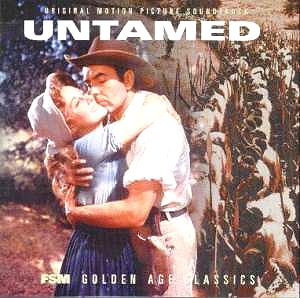[Available exclusively from the magazine and website (www.filmscoremonthly.com) for $19.95 plus shipping: Film Score Monthly, 8503 Washington Boulevard, Culver City, CA 90232, ph: 310-253-9595 or toll-free 1-888-345-6335; fax: 310-253-9588; Lukas@filmscoremonthly.com]
Because of its controversial setting – mid-19th century South Africa and the building of an independent Dutch Boer state, Untamed has tended to sink into semi-obscurity – no video release has ever appeared and the film is seldom seen on TV. It is a typical 20th Century Fox CinemaScope romantic adventure film, from 1955, a sort of Gone With the Wind with the headstrong, flighty heroine Katie (Susan Hayward) pursuing the rugged hero Paul Van Riebeck (Tyrone Power) from Ireland to South Africa. He is torn between love for her and for his emerging state, while Katie is pursued by the brutish and jealous Kurt Hout (Richard Egan) and menaced by warring Zulus, storms and the dangers in the wild terrain of South Africa.
Appropriately Franz Waxman wrote a full-blooded, romantic score. It begins with the always welcome 20th Century Fox fanfare with the stirring CinemaScope extension. The main title music really arrests the attention. After a short lilting woodwind introduction to set the opening scene in Ireland, there is an extended passage of fanfares echoing right across the sound stage (fully showing off theatres’ stereo sound systems). These were recorded separately from the full orchestra. As the title card appears so Waxman surges forth with his main theme – a wonderfully bold romantic melody that magically has the source-like horn calls interpolated as answers to each melodic phrase. For this opening scene is a fox hunt and it introduces Katie. Already she is determined to snare Paul but he is more concerned with returning to South Africa with badly needed horses. The main romantic theme will be slowly developed through the score until it flowers most strongly in the cue ‘After the Fight/By the River’ in which Paul and Katie develop their land in South Africa.
There are many highlights. A remarkable track is the ‘Zulu Attack’ – although it is not a Waxman composition (he supervised the recording on the Fox stage) but a compelling collage of various percussion overlays recorded "wild" for use in dubbing the picture. Nearly a dozen separate overlays were made from repeating "jungle" drums to short shakers and quasi-vocal exclamations ("war cries"). There is droning yet tense music for the journeys and the dangers of the trek as when a wagon goes out of control and plunges over a high cliff (a magnificently photographed sequence that lingers on the retina). Then there is the powerfully evocative music for Kurt working on Katie’s land, when Paul goes off to fight with his commandos. Intense and plodding, it conveys Kurt’s growing frustration with Katie’s cruelty in taking advantage of his unrequited love – his pent-up passion overflowing as he attempts to rape her, with the music screaming frenetically as lightning smites the big tree outside her home, saving her and pinning him down.
The documentation is well up to Film Score Monthly’s high standard with informative notes on the production of the film and a full analysis of the score. Not to be missed by lovers of Franz Waxman’s music and unashamed romantics
Ian Lace


